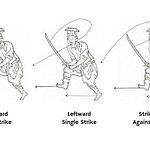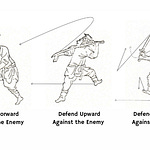Duration: 8-10 minutes
Proper Stances: The Foundation of Martial Arts
Proper stances form the foundation of martial arts techniques, providing stability, power, and mobility. Think of them as the roots of a tree—the stronger your base, the more powerful and controlled your movements become.
For beginners, we recommend starting with our foundational stances video (see the video below), which focuses exclusively on foot and leg positioning. This approach allows you to develop muscle memory and body awareness without the complexity of arm movements.
Once you feel comfortable with the basic leg work and can maintain these stances naturally, you can progressively integrate arm postures to build comprehensive stances. This step-by-step approach ensures a solid learning progression and helps prevent overwhelm during the initial learning phase.
1. Bow-Arrow Stance
Right Side:
Front foot turned in 30 degrees, back foot pointing forward.
Front leg bent like drawing a bow.
Back leg straight but not locked.
Weight distribution: 70% front, 30% back.
Hips squared forward.
Left Side:
Mirror the position.
Maintain the same principles.
Check your alignment.
Common Mistakes:
❌ Front knee extending past toes.
❌ Back heel lifting.
❌ Collapsing the torso.
2. Horse-Riding Stance
The Horse-Riding stance builds powerful legs and stability.
Feet parallel, wider than shoulders.
Toes pointing forward.
Knees bent equally.
Back straight.
Equal weight distribution.
Sink your weight.
Watch for:
❌ Knees collapsing inward.
❌ Feet turning outward.
❌ Shoulders tensing.
3. Empty Stance
Left and Right Empty Stance:
95% weight on back leg.
Front foot lightly touching the ground.
Back foot at 45 degrees.
Front foot pointing forward.
Maintain upright posture.
Ready to transition.
Key Points:
✅ Stay relaxed but alert.
✅ Maintain balance.
✅ Be ready to move.
4. Single-Leg Stance
Both Sides:
Standing leg slightly bent.
Raised knee at hip height.
Foot flexed.
Upper body straight.
Arms stretching upward and downward.
Head turns and looks plainly forward.
Practice Tips:
✅ Start near a wall for support.
✅ Build duration gradually.
✅ Keep breathing steady.
5. Crouching Stance
Left and Right Sides:
Lower body weight.
Back straight.
Lead leg bent deeply.
Back leg stretching.
Maintain head level.
Focus on:
✅ Core engagement.
✅ Hip flexibility.
✅ Knee alignment.
6. Half-Kneel Stance
Both Sides:
60% weight on front leg.
Back leg ready to adjust.
Upper body relaxed.
Arms in a pushing position.
Maintain rootedness.
Stay mobile.
Important Aspects:
✅ Breathe naturally.
✅ Stay relaxed but strong.
✅ Be ready to respond.
7. Coiled-Leg Stance
Both Sides:
60% weight on front leg, 40% on back leg.
Upper body relaxed.
Ready to leverage momentum.
Important Aspects:
✅ Relax shoulders.
✅ Keep core strong but flexible.
✅ Don’t collapse the torso.
Practice Integration
Practice Sequence:
✅ Hold each stance for 30 seconds.
✅ Flow between similar stances.
✅ Practice transitions.
✅ Check alignment regularly.
Strong stances build a strong foundation. Practice these daily, and you’ll see improvement in all aspects of your martial arts journey.














Share this post